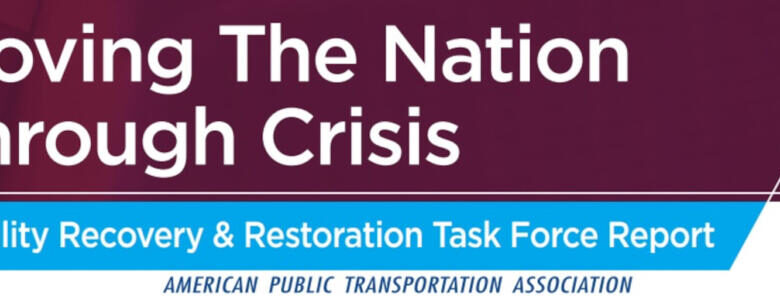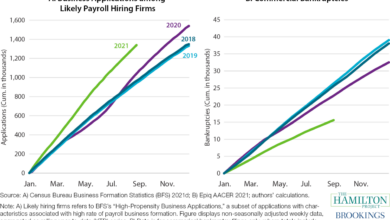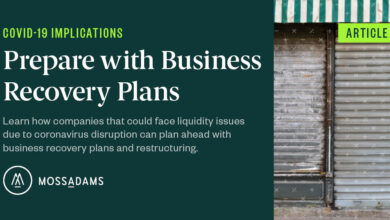
Coronavirus Recovery Pushes CFOs to Improve Scenario Planning
Coronavirus recovery pushes CFOs to improve scenario planning. Companies are shifting from crisis management to long-term growth and sustainability. This new reality necessitates a more proactive and adaptable approach to financial planning, leading CFOs to prioritize risk management and strategic planning. The pandemic recovery has dramatically altered the landscape, demanding a deep dive into potential future scenarios, from optimistic to pessimistic, to effectively navigate the uncertainties ahead.
This in-depth analysis examines the critical role of scenario planning in today’s business environment. We’ll explore the key factors driving CFO decisions, practical strategies for implementation, essential tools, and real-world case studies. Furthermore, we’ll look ahead to future trends and the evolving role of scenario planning in the post-pandemic world.
Impact of Coronavirus Recovery on CFO Priorities
The coronavirus pandemic dramatically reshaped the business landscape, forcing CFOs to navigate unprecedented challenges. Companies faced a complex web of issues, from supply chain disruptions and workforce volatility to fluctuating demand and financial uncertainty. The initial response was largely focused on crisis management, but the recovery period brought a crucial shift in priorities, emphasizing long-term resilience and sustainable growth.The recovery period ushered in a new era of financial management, where CFOs moved beyond simply weathering the storm to actively shaping the future.
This transition required a deep understanding of the changing market dynamics and a proactive approach to long-term strategic planning. This shift in focus was driven by the need to rebuild and restructure businesses for a post-pandemic world.
Key Financial Challenges During Recovery
The coronavirus pandemic recovery period presented a unique set of financial challenges. Companies faced difficulties in adapting to new market realities, such as fluctuating demand, supply chain bottlenecks, and a changing consumer landscape. Maintaining liquidity and managing cash flow effectively became critical concerns. Additionally, many businesses experienced increased operating costs due to factors like higher raw material prices and increased labor expenses.
Recovering from the financial impact of the pandemic and implementing strategies for long-term sustainability became essential.
Shift in Financial Priorities
The initial focus on crisis management gave way to a more strategic and long-term perspective. Companies prioritized building resilience, developing sustainable business models, and creating value for stakeholders beyond just short-term profits. This shift involved a significant reallocation of resources and a reevaluation of core business strategies. The need to ensure long-term profitability and growth became a primary objective.
Impact on Risk Management and Strategic Planning
The pandemic underscored the importance of robust risk management and strategic planning. CFOs recognized the need for more comprehensive scenario planning, encompassing a wider range of potential outcomes, including both positive and negative scenarios. This proactive approach helped companies to prepare for future uncertainties and develop contingency plans. Risk assessments became more sophisticated, incorporating new variables like health-related risks and supply chain vulnerabilities.
CFO Priorities Before and After Coronavirus Recovery
| Company Size | Focus Area (Before Recovery) | Specific Actions (Before Recovery) | Measurable Results (Before Recovery) |
|---|---|---|---|
| Small | Liquidity Management | Implementing cost-cutting measures, exploring government aid programs | Preservation of working capital, short-term survival |
| Medium | Short-term profitability | Adjusting production lines, optimizing inventory levels | Maintaining revenue streams, improving operational efficiency |
| Large | Crisis management | Diversifying supply chains, strengthening financial reserves | Minimizing disruption, maintaining market share |
| Small | Long-term growth and sustainability | Investing in digital transformation, exploring new markets | Increased market share, improved profitability, customer acquisition |
| Medium | Adaptability and resilience | Developing contingency plans, improving supply chain agility | Reduced downtime, improved operational efficiency, and customer retention |
| Large | Strategic risk management | Implementing advanced scenario planning, diversifying revenue streams | Enhanced preparedness for future disruptions, improved financial stability, and long-term value creation |
Scenario Planning as a Crucial Tool for CFOs
The post-pandemic business landscape is characterized by unprecedented uncertainty. Economic recovery is uneven, supply chains are fragile, and geopolitical tensions are escalating. Navigating this complex environment demands a proactive approach, and scenario planning is emerging as a critical tool for CFOs to anticipate potential disruptions and make informed decisions. CFOs need to move beyond simple forecasting and embrace a more holistic view of potential future states.Scenario planning is not about predicting the future with certainty, but about exploring a range of plausible futures and preparing for a variety of outcomes.
By considering various economic scenarios, CFOs can identify potential risks and opportunities, develop contingency plans, and ultimately enhance their organization’s resilience. It allows for a more comprehensive view of the potential impact of various external factors, fostering a more agile and adaptable approach to strategic decision-making.
Discover how cima ethics confidentiality rules has transformed methods in this topic.
Economic Scenarios CFOs Need to Consider
Different economic scenarios present unique challenges and opportunities for businesses. CFOs need to develop plans that account for various potential futures. These scenarios should extend beyond a simple “optimistic-pessimistic” dichotomy and incorporate a wider range of possibilities.
- Optimistic Scenario: Rapid economic recovery, robust consumer spending, and sustained growth across various sectors. This scenario assumes a return to pre-pandemic levels of economic activity and market confidence. For example, consider a resurgence of travel and tourism following the pandemic’s easing, leading to increased demand for hospitality services.
- Pessimistic Scenario: Prolonged economic downturn, significant inflation, and global recessionary pressures. This scenario assumes a sustained period of economic hardship and market volatility. For example, a global recession might lead to a contraction in consumer spending and a decline in demand for certain products.
- Neutral Scenario: A moderate pace of economic recovery, a mix of inflationary and deflationary pressures, and fluctuating market conditions. This scenario assumes a more gradual return to normalcy with a range of factors influencing the pace of economic growth and consumer behavior. For example, a moderate recovery might see a slow increase in consumer spending and a gradual improvement in supply chain stability.
Incorporating External Factors
Effective scenario planning requires a comprehensive understanding of external factors that could impact the business. Geopolitical events and supply chain disruptions are key elements to consider. Unforeseen events like trade wars or natural disasters can significantly affect the operating environment and demand for products. Developing robust contingency plans for these possibilities is vital for long-term business sustainability.
Developing Scenario Planning Processes
A structured approach to scenario planning is essential for its successful implementation. It’s crucial to define clear objectives, identify key variables, and develop a framework for analyzing and evaluating potential outcomes.
| Step | Description | Resources | Timeline |
|---|---|---|---|
| 1. Define Objectives | Establish clear goals for scenario planning, such as identifying potential risks, evaluating alternative strategies, or improving organizational resilience. | Executive leadership, relevant department heads | 1-2 weeks |
| 2. Identify Key Variables | Identify external and internal factors that could significantly impact the business. This includes economic indicators, market trends, and potential geopolitical events. | Market research reports, industry analysis, expert consultations | 2-4 weeks |
| 3. Develop Scenarios | Construct a range of plausible scenarios based on different combinations of identified variables. These scenarios should span optimistic, pessimistic, and neutral outcomes. | Data analysis tools, forecasting models, brainstorming sessions | 4-6 weeks |
| 4. Analyze Potential Outcomes | Evaluate the impact of each scenario on key business metrics, such as revenue, profitability, and market share. | Financial modeling tools, simulation software, data visualization tools | 6-8 weeks |
| 5. Develop Contingency Plans | Develop specific action plans for each scenario, outlining potential responses and strategies to mitigate risks and capitalize on opportunities. | Cross-functional teams, subject matter experts | 8-10 weeks |
| 6. Monitor and Update | Regularly monitor the external environment and update the scenario plans as new information emerges. | Market intelligence, financial data, news sources | Ongoing |
Key Factors Influencing Scenario Planning Decisions
Scenario planning has emerged as a critical tool for CFOs navigating the complexities of a post-pandemic world. The unpredictable nature of the economic recovery, coupled with evolving market dynamics, necessitates a proactive approach to future-proofing financial strategies. CFOs are increasingly recognizing the value of scenario planning in anticipating potential disruptions and developing robust contingency plans.The core of effective scenario planning lies in understanding the multifaceted factors influencing future outcomes.
These factors, ranging from market shifts to technological advancements, require meticulous analysis and consideration. By incorporating these elements into financial models, CFOs can gain a deeper understanding of potential risks and opportunities, enabling them to make more informed decisions.
Market Trends and Their Impact
Market trends significantly influence scenario planning decisions. Analyzing historical data and current market conditions is crucial for anticipating future developments. Identifying emerging trends, such as shifting consumer preferences or evolving industry regulations, allows CFOs to adjust their strategies accordingly. For example, the rise of e-commerce has dramatically reshaped retail landscapes, forcing traditional brick-and-mortar stores to adapt their business models.
This shift necessitates scenario plans that consider varying levels of e-commerce adoption and its impact on revenue streams. Similarly, the growing demand for sustainable products and services is prompting companies to adapt their supply chains and production methods.
Customer Behavior Shifts and their Impact
Customer behavior shifts are another key driver in scenario planning. Changes in consumer preferences, purchasing habits, and brand loyalty directly impact revenue projections and marketing strategies. Scenario planning models should incorporate these shifts to gauge potential impacts on demand and profitability. For instance, the pandemic accelerated the adoption of digital payment systems, leading to a surge in online transactions.
Scenario plans must consider the potential for continued growth in digital transactions and the implications for traditional payment methods. This necessitates the adaptation of financial models to account for the impact of this shift on revenue generation and customer acquisition strategies.
Technological Advancements and their Impact
Technological advancements play a crucial role in shaping the future landscape. Scenario planning must account for the potential impact of new technologies on operational efficiency, customer engagement, and market competition. For instance, automation is transforming industries by streamlining processes and reducing labor costs. Scenario planning should assess the potential for increased automation and its effect on employment and profitability.
The emergence of artificial intelligence (AI) is another significant driver, impacting customer service, product development, and overall business strategies. Financial models should consider the potential of AI and its impact on market share and competitive positioning.
Financial Modeling in Assessing Scenario Impacts
Financial modeling is indispensable for assessing the impact of different scenarios on financial performance. By inputting various assumptions into financial models, CFOs can simulate different outcomes and identify potential risks and opportunities. This process involves developing detailed projections of revenue, costs, and profitability under diverse scenarios.
A crucial element of financial modeling is the use of sensitivity analysis, which helps quantify the impact of changes in key variables on financial performance.
Comparison of Financial Modeling Techniques
Various financial modeling techniques can be employed for scenario planning. Discounted cash flow (DCF) analysis is a widely used method for valuing companies and projects under different scenarios. Simulation models, such as Monte Carlo simulations, can be used to analyze the probability of various outcomes and their impact on financial performance. Regression analysis can be employed to identify relationships between different variables and to forecast future trends.
Impact of Scenarios on Key Financial Metrics
The table below illustrates the potential impact of different scenarios on key financial metrics:
| Scenario | Revenue | Costs | Profitability |
|---|---|---|---|
| Scenario 1: Optimistic | Increased by 15% | Reduced by 10% | Increased by 25% |
| Scenario 2: Moderate | Increased by 5% | Reduced by 5% | Increased by 10% |
| Scenario 3: Pessimistic | Decreased by 10% | Increased by 15% | Decreased by 20% |
This table provides a simplified illustration. Actual impacts will vary based on specific industry conditions and company-specific factors.
Strategies for Implementing Effective Scenario Planning

Scenario planning, a powerful tool for navigating uncertainty, requires careful implementation. It’s not just about creating hypothetical scenarios; it’s about embedding a proactive, adaptable mindset throughout the organization. This process transforms from a theoretical exercise to a practical roadmap for success.Effective scenario planning isn’t a one-time event; it’s a continuous cycle of analysis, adaptation, and refinement. By implementing the right strategies, organizations can leverage scenario planning to anticipate potential challenges and seize emerging opportunities.
This approach empowers businesses to navigate complex environments with confidence and resilience.
Key Strategies for Implementing Scenario Planning
Scenario planning, when implemented effectively, becomes an integral part of an organization’s strategic decision-making process. It involves a structured approach to analyzing potential futures, enabling informed choices and actions. Crucially, these strategies need to be tailored to the specific context and resources of each organization.
- Develop a Comprehensive Framework: A well-defined framework is essential for scenario planning. This involves clearly outlining the key uncertainties and variables that could significantly impact the organization. This process should involve diverse perspectives from across the organization, ensuring that the framework captures a wide range of potential futures.
- Establish a Dedicated Team: A dedicated team with diverse expertise is critical for scenario planning. This team should include individuals with relevant experience in various departments, such as finance, marketing, operations, and technology. Their diverse knowledge base helps create a more comprehensive and realistic view of the potential scenarios.
- Data Collection and Analysis: Collecting and analyzing relevant data is paramount. This includes market research, industry trends, economic forecasts, and competitive intelligence. The data should be carefully evaluated and analyzed to identify patterns and potential risks or opportunities. This stage involves meticulous research, careful data interpretation, and collaboration across teams.
- Developing Plausible Scenarios: This crucial step involves creating plausible scenarios that explore the different potential futures. These scenarios should be distinct and mutually exclusive, covering a range of possible outcomes. This is often achieved through brainstorming sessions, workshops, and expert interviews. The focus is on generating a comprehensive view of the possible futures rather than predicting a specific outcome.
Communicating Scenario Plans to Stakeholders
Effective communication is vital for ensuring that scenario plans are understood and utilized by all relevant stakeholders. This process involves clear articulation of the potential outcomes and their implications.
- Investor Communication: Investors need a clear understanding of the organization’s preparedness for various economic and market conditions. Present the scenario plans in a transparent and concise manner, highlighting the potential risks and opportunities. Crucially, focus on the organization’s ability to adapt and mitigate potential challenges, emphasizing its resilience.
- Employee Communication: Communicating scenario plans to employees helps build a shared understanding of the organization’s challenges and opportunities. Clearly explain how the plans will affect their roles and responsibilities. This process fosters a sense of shared purpose and encourages proactive engagement. Focus on the potential impact on their daily work and highlight the role they play in mitigating risks.
- Board Member Communication: The board requires a high-level overview of the scenarios and their implications. The presentation should focus on the strategic implications of each scenario and how the organization plans to respond. Demonstrate how scenario planning will support the board’s oversight responsibilities.
Regular Reviews and Adjustments
Scenario plans are not static documents; they need continuous review and adaptation. This process ensures that the plans remain relevant and effective in light of changing circumstances.
- Regular Reviews: Scheduled reviews are crucial to evaluating the validity and relevance of the scenario plans. This allows the organization to assess the accuracy of initial assumptions and make necessary adjustments based on new information.
- Feedback Mechanisms: Establish channels for feedback from all stakeholders. This feedback helps identify gaps in the scenario planning process and allows for adjustments to be made based on real-world experiences.
- Adaptability: Scenario plans should be designed to adapt to evolving circumstances. This includes regularly updating assumptions and refining the scenarios to reflect new data and insights.
Integrating Scenario Planning into Strategic Planning
Scenario planning should be integrated into the overall strategic planning process. This ensures that strategic decisions are informed by a thorough understanding of potential futures.
- Strategic Alignment: Scenario plans should be aligned with the organization’s overall strategic goals. This ensures that strategic decisions are informed by a thorough understanding of potential futures.
- Resource Allocation: Scenario planning helps in aligning resource allocation with the potential outcomes of different scenarios. This ensures that resources are deployed effectively in response to anticipated changes.
Communication Methods for Different Stakeholders
| Stakeholder Group | Communication Method |
|---|---|
| Investors | Formal presentations, investor reports, dedicated investor calls |
| Employees | Internal newsletters, town hall meetings, departmental briefings, training sessions |
| Board Members | Board meetings, executive summaries, presentations, dedicated briefings |
Tools and Technologies for Scenario Planning
Navigating the complexities of the post-pandemic business landscape requires CFOs to be agile and adaptable. Scenario planning, a powerful tool for anticipating potential futures, becomes even more critical. The right tools and technologies can streamline this process, enabling CFOs to make data-driven decisions and prepare for a range of possible outcomes.Effective scenario planning demands robust analytical capabilities and a flexible framework for modeling different possibilities.
Choosing the right software can significantly enhance the process, from gathering and analyzing data to visualizing potential outcomes. This is where the power of technology truly shines.
Learn about more about the process of global cfo survey rebuild revenue streams in the field.
Available Tools and Technologies
A variety of software and platforms cater to scenario planning needs. These tools range from spreadsheet-based solutions to dedicated scenario planning platforms. The selection depends on the specific requirements of the organization, including the complexity of the scenarios and the volume of data involved. Some tools are geared towards smaller businesses, while others are tailored for large enterprises with complex financial models.
Examples of Scenario Planning Software
Several software applications and platforms facilitate scenario planning efforts. Examples include:
- Spreadsheet software (e.g., Microsoft Excel, Google Sheets): While simple spreadsheets can be used for basic scenario planning, they often become cumbersome as the complexity increases. They are suitable for small-scale projects with limited data.
- Dedicated scenario planning software (e.g., Apex, Planview, and others): These platforms are designed specifically for scenario planning. They often offer advanced features like interactive visualizations, robust data integration, and collaborative workspaces. These platforms can be more expensive but are more efficient for larger-scale or complex analyses.
- Business intelligence (BI) platforms (e.g., Tableau, Power BI): These platforms can be leveraged to visualize and analyze data related to scenarios. BI tools can be valuable for identifying trends and patterns in data that might be missed through other methods.
Key Features of Effective Scenario Planning Tools
Effective scenario planning tools should offer specific features to support CFOs:
- Data Import and Integration Capabilities: The ability to import and integrate data from various sources (financial statements, market research, etc.) is crucial for creating accurate and comprehensive scenarios.
- Interactive Visualization and Modeling: Interactive dashboards and tools that allow for visualization of different scenarios and their potential impacts on key financial metrics (e.g., revenue, cost, profitability) are essential.
- Collaboration and Communication Tools: Features supporting collaboration among different stakeholders (e.g., finance, operations, marketing) are essential to ensure that diverse perspectives are considered during the planning process.
- Scenario Management and Tracking: Tools that enable effective management of different scenarios, tracking their performance over time, and comparing their outcomes can provide valuable insights for decision-making.
The Role of Data Analytics in Scenario Planning
Data analytics is critical to scenario planning. It allows CFOs to gain insights into historical trends, identify potential future risks and opportunities, and make informed decisions based on the available data. Predictive analytics can also be used to forecast future outcomes and assess the potential impact of various factors on the organization’s financial performance. The analysis of market data, industry trends, and competitor strategies provides a more comprehensive understanding of the external environment.
Data-driven decision-making is paramount in scenario planning.
Comparing Scenario Planning Tools
The following table provides a comparison of different scenario planning tools, considering their features, pricing, and ease of use. Note that pricing and ease of use are highly dependent on the specific needs and functionalities required by each organization.
| Tool | Features | Pricing | Ease of Use |
|---|---|---|---|
| Microsoft Excel | Basic scenario modeling, limited visualization | Included with Microsoft 365 subscription | High |
| Apex | Comprehensive scenario planning, robust data integration, advanced visualizations | Variable, often per user/module | Medium |
| Planview | Collaborative platform for scenario planning, project management, and resource allocation | Variable, often per user/module | Medium |
| Tableau | Data visualization, interactive dashboards, advanced analytics | Variable, often per user/module | Medium-High |
Illustrative Case Studies of Scenario Planning
Scenario planning, a powerful strategic tool, proved invaluable during and after the pandemic recovery. Companies that proactively considered various potential futures adapted more swiftly and effectively to evolving market conditions. By anticipating challenges and opportunities, they enhanced their resilience and positioned themselves for success.Scenario planning allows businesses to prepare for multiple possible outcomes, instead of relying on a single, often overly optimistic, forecast.
It’s not about predicting the future, but about understanding the range of possibilities and developing strategies to navigate them. This proactive approach is crucial in times of uncertainty, such as the period following the COVID-19 pandemic.
Expand your understanding about how to clearly communicate feedback and expectations with the sources we offer.
Successful Scenario Planning in Retail
Retailers, particularly those with large brick-and-mortar presences, faced unprecedented challenges. E-commerce surged, and consumer habits shifted dramatically. Proactive scenario planning was critical to their survival and growth.
- Company: Target Corporation
- Industry: Retail
- Scenario: Rapid increase in online shopping coupled with a potential decline in in-store traffic.
- Strategy: Target implemented a multi-pronged approach. They significantly invested in their online platform, improving website functionality and delivery options. Simultaneously, they reimagined their in-store experience, focusing on enhanced customer service, personalized shopping experiences, and curated product offerings to compete with the rise of online shopping. They also invested in click-and-collect services to combine online and in-store shopping.
- Results: Target’s proactive approach allowed them to maintain market share. Their diversified strategy ensured continued profitability during the transition and positioned them well for future growth. They successfully managed the shift to omnichannel retail.
Successful Scenario Planning in Technology
The technology sector saw significant disruptions and shifts in consumer behavior, leading to evolving business needs.
- Company: Microsoft
- Industry: Technology
- Scenario: Increased remote work and collaboration requirements.
- Strategy: Microsoft’s scenario planning anticipated the growing need for cloud-based collaboration tools and remote work solutions. They invested heavily in their Azure cloud platform, enhancing its capabilities for remote access and team collaboration. They also adapted their existing products to meet the evolving demands of remote work, providing remote support and educational resources.
- Results: Microsoft’s anticipatory strategy ensured continued growth and market leadership. The enhanced offerings allowed them to capitalize on the surge in demand for cloud-based solutions. Their proactive approach boosted their position as a major provider of remote work and collaboration tools.
Illustrative Table of Case Studies
| Company | Industry | Scenario | Strategy | Results |
|---|---|---|---|---|
| Target | Retail | Increased online shopping, declining in-store traffic | Omnichannel strategy, enhanced online platform, reimagined in-store experience | Maintained market share, increased profitability, successfully managed transition |
| Microsoft | Technology | Increased remote work and collaboration requirements | Investment in Azure cloud platform, adaptation of existing products for remote use | Continued growth and market leadership, capitalized on demand for cloud solutions |
Future Outlook of Scenario Planning
Scenario planning, once a niche activity for large corporations, is rapidly becoming a critical tool for CFOs across all industries. The volatile and unpredictable nature of the modern business environment demands a proactive approach to anticipate potential disruptions and navigate uncertain futures. CFOs are recognizing the value of scenario planning as a means to not just react to events, but to anticipate them and adapt strategies accordingly.The future of scenario planning hinges on its ability to adapt to evolving business landscapes and technological advancements.
This evolution will involve not only refining traditional methods but also incorporating emerging technologies to enhance its effectiveness and accessibility. The increasing complexity of global markets and the ever-present threat of unforeseen crises necessitates a forward-looking approach that goes beyond simple forecasting.
Future Trends and Developments
Scenario planning is evolving from a theoretical exercise to a practical, integrated component of strategic decision-making. This shift is driven by the need for more agile and responsive organizations. CFOs are increasingly integrating scenario planning into their core business functions, realizing its value in risk mitigation and opportunity identification. Furthermore, the increasing use of data analytics and advanced modeling techniques is transforming scenario planning into a more sophisticated and predictive tool.
Emerging Challenges and Opportunities
The evolving business landscape presents both challenges and opportunities for scenario planning. Globalization, technological disruption, and geopolitical instability create a complex environment demanding sophisticated models. The increasing interconnectedness of markets also means that unforeseen events in one region can quickly ripple across the globe, affecting various industries. However, these challenges also represent opportunities for scenario planning to demonstrate its value in navigating uncertainty and identifying emerging market trends.
A well-structured scenario planning process can help organizations anticipate and prepare for these disruptions, enhancing resilience and adaptability.
Role of Artificial Intelligence and Machine Learning, Coronavirus recovery pushes cfos to improve scenario planning
Artificial intelligence (AI) and machine learning (ML) are poised to revolutionize scenario planning. AI algorithms can process vast datasets, identify patterns, and predict potential future scenarios with greater accuracy and speed than traditional methods. This ability to analyze complex data from diverse sources, including social media sentiment, economic indicators, and market research, will significantly enhance the accuracy and timeliness of scenario planning.
Machine learning models can also be used to refine and update scenarios as new data becomes available, creating a dynamic and responsive planning framework.
Integration with Other Strategic Tools
Scenario planning should not exist in isolation. Its effectiveness is significantly enhanced when integrated with other strategic tools, such as budgeting, forecasting, and risk management. By combining scenario planning with these tools, organizations can create a more holistic and comprehensive view of their future prospects. The integrated approach allows for a more realistic assessment of potential outcomes, leading to more robust and adaptable strategies.
Furthermore, scenario planning can inform and refine the inputs for other strategic tools, ensuring they are aligned with the identified potential futures.
Summary of Future Trends
| Future Trend | Potential Impact on Scenario Planning |
|---|---|
| Increased Data Availability and Sophistication | Enhanced accuracy and speed of scenario development; identification of previously unseen patterns; improved predictive capability. |
| Rise of AI and Machine Learning | Automation of data analysis and scenario generation; improved scenario refinement and adaptation; greater speed and efficiency. |
| Integration with other Strategic Tools | Creation of a more holistic and comprehensive view of future prospects; alignment of strategies with potential outcomes; more robust and adaptable strategies. |
| Growing Complexity of Global Markets | Necessity for more sophisticated scenario planning; improved understanding of interconnectedness of global markets; enhanced ability to anticipate and mitigate disruptions. |
Wrap-Up: Coronavirus Recovery Pushes Cfos To Improve Scenario Planning

In conclusion, the coronavirus recovery has accelerated the need for CFOs to embrace scenario planning. This proactive approach to risk management and strategic planning is crucial for navigating the complex and unpredictable future. By incorporating various economic scenarios, external factors, and financial modeling, CFOs can better position their organizations for success. The ability to adapt and respond effectively to different possibilities will be a key differentiator in the years to come.





